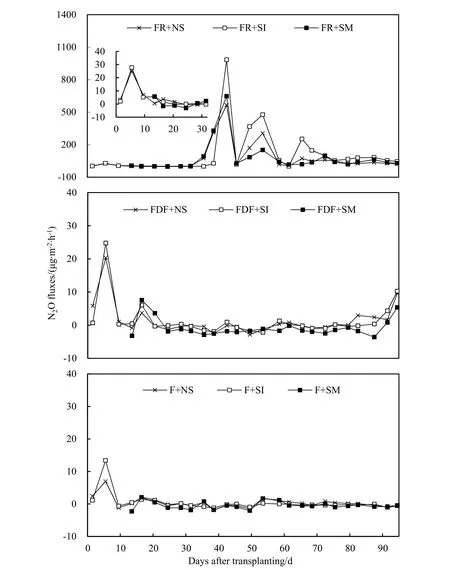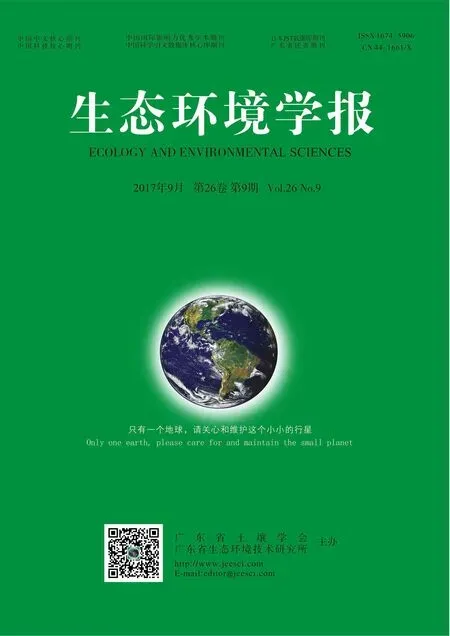稻草还田方式对不同水分类型稻田土壤N2O排放的影响
2017-10-16吴小红王卫侯海军谢小立
吴小红,王卫*,侯海军,谢小立
稻草还田方式对不同水分类型稻田土壤N2O排放的影响
吴小红1,2,王卫2*,侯海军2,谢小立2
1. 中南林业科技大学生命科学与技术学院,湖南 长沙 410004;
2. 中国科学院亚热带农业生态研究所//亚热带农业生态过程重点实验室,湖南 长沙 410125
稻田是重要的N2O排放源,而稻田N2O排放与土壤水分和施肥密切相关。南方丘陵区是中国水稻的重要生产地,然而由于地形海拔的差异,稻田的水分条件相差很大。该地域典型的稻田水分包括持续淹水、中期晒田(除中期晒田和收获前落干外,保持淹水)以及耕灌雨养(灌水整地插秧,水稻分蘖盛期后不灌溉,依靠自然降水)。稻草还田为土壤微生物提供了大量的碳、氮基质,不同的稻草还田方式(深施、表施)会影响微生物对稻草中的碳、氮的利用,从而可能会影响 N2O排放。采用静态箱-气象色谱法研究了南方丘陵区稻田土壤在不同水分条件(持续淹水、常规灌溉和耕灌雨养)下,秸秆还田方式(无稻草、稻草翻耕入土、稻草覆盖)对N2O排放的影响。当土壤有水层时,N2O排放微乎其微;当水层落干后,N2O排放快速上升。耕灌雨养的N2O累积排放通量显著高于常规灌溉和持续淹水处理的N2O累积排放通量。在耕灌雨养条件下,稻草翻耕入土处理下N2O排放为2.566 kg∙hm-2,比无稻草处理增加54%,而稻草覆盖处理对N2O排放影响很小。在常规灌溉和持续淹水条件下,无论是否进行稻草还田,N2O排放均很弱,仅为-0.003~0.030 kg∙hm-2。研究结果表明,水分是调控稻田N2O排放的主要因子,在田间无水层条件下,稻草翻耕入土有促进N2O排放的潜力。
N2O;水分管理;秸秆还田;稻草覆盖
N2O是一种重要的温室气体,至2015年,N2O在大气中的体积分数达到328 nL·L-1,最近10年平均每年上升0.89 nL·L-1(WMO,2016)。据估算,农田土壤N2O排放占全球人为排放的50%(Smith et al.,2007)。中国水稻种植面积世界第二,总产量世界第一,对中国粮食生产起到了重要作用,但稻田也是重要的N2O排放源,并且N2O排放受田间水分管理和施肥影响(Ma et al.,2009;Shang et al.,2011;Zou et al.,2005)。
南方丘陵区是中国水稻的重要生产地,然而由于地形海拔的差异,稻田的水分条件相差很大。随着海拔的降低,稻田能够蓄积较多的径流和壤中流,并且拥有较多的灌溉水源,所以低处的稻田几乎一直淹水,而高处的稻田缺乏灌溉条件,主要依靠降雨。为了防备可能的干旱,农民一般不会随意排水,除非水层过深或需中期晒田促进水稻生长。该地域典型的稻田水分包括持续淹水、中期晒田以及耕灌雨养。稻草是水稻生产的主要副产品,约占水稻地上生物量的50%。由于稻草的资源化利用水平较低、政府禁止焚烧秸秆以及维持土壤肥力等原因,稻草还田成了农民处理稻草的主要选择。
土壤微生物的硝化反硝化过程是产生 N2O的主要途径,该过程受土壤碳、氮水平以及土壤水分条件影响(Bateman et al.,2005;Dobbie et al.,2003;Oertel et al.,2016)。前人的研究表明,淹水状态下的稻田很少排放N2O,而土壤的干湿交替过程促进稻田 N2O 的排放(Liu et al.,2012;Zou et al.,2005;Zou et al.,2009),N2O排放与土壤水分含量也存在显著相关关系(Chen et al.,2014;Yan,2013)。稻草还田为土壤微生物提供了大量的碳、氮基质,可能会对稻田 N2O排放产生消极或积极的影响(Huang et al.,2004;Swerts et al.,1996;Zou et al.,2005)。一方面,添加稻草会增加微生物的活性和土壤氧气消耗,进而导致更强烈的土壤厌氧环境(Miller et al.,2008;Swerts et al.,1996;Zou et al.,2005)。另一方面,稻草所含有机氮的矿化可以释放出铵态氮,促进土壤硝化作用,产生N2O(Charles et al.,2017)。同时,不同的稻草还田方式(深施、表施)会影响微生物对稻草中的碳、氮的利用,从而可能会影响N2O排放。有研究表明,水分和秸秆对N2O排放没有显著交互作用(Kim et al.,2014;Wang et al.,2011)。为探明不同水分条件下稻草还田方式对N2O排放的影响,本研究设置了秸秆还田方式(不还田、翻耕入土、覆盖还田)和水分条件(长期淹水、晒田、耕灌雨养)交叉分组实验,并监测了稻田N2O通量,以期为稻田水分与秸秆管理提供科学依据。
1 材料与方法
1.1 试验区域概况
试验在中国科学院桃源农业生态试验站进行。该地处于 111°27′E,28°55′N,年平均气温为16.5 ℃,年降水量为1448 mm,年日照时数为1531 h,年太阳辐射总量为427.5 kJ∙cm-2。土壤为第四纪红色黏土发育而成的水稻土。
1.2 试验设计
2014年7月23日—10月24日,在稻田长期水分管理定位试验田开展试验,其部分土壤理化性质见表1。本研究利用长期定位试验的3个水分处理的原位土壤及水分条件,监测稻草还田方式对不同水分类型稻田土壤温室气体的排放规律。处理I持续淹水(F,周年淹灌2~10 cm水层,代表水资源富余的低洼稻田)、处理Ⅱ常规灌溉(FDF,休闲期田间排水,除中期晒田和收获前落干外,水稻大田期保持淹水,代表灌排条件良好的高产稻田)和处理Ⅲ耕灌雨养(FR,灌水整地插秧,水稻分蘖盛期后不灌溉,依靠自然降水,代表灌溉条件差的高岸水田)。研究期间田间具体水分状况见图1。本研究采用交叉分组的两因素无重复试验设计。在同一水分处理的 3个重复小区内分别设置不同稻草还田方式的微区,分别为稻草覆盖(SM,水稻移栽后第10天开始覆盖,模拟在水稻返青后进行稻草覆盖)、稻草翻耕入土(SI,整田时将稻草翻耕入土)和不还田(NS)。稻草添加量为 5000 kg∙hm-2。所有处理的尿素添加量折算为纯氮 101 kg∙hm-2。

表1 耕层土壤(0~20 cm)基本理化性质Table 1 Properties of top soil (0~20 cm) under different water treatments

图1 试验期间不同水分处理田间水位变化Fig. 1 Variation of water depth under different water treatments during experimental period
1.3 测定项目
1.3.1 N2O的采集与测定
利用采气箱采集气体样品。采气箱为圆柱形,底座直径45 cm,箱体高15 cm。一般每隔3~4 d采集1次气体样品,采样时间在上午9:20—10:40之间。具体操作为:分别在第 0、15、30、45和 60分钟时,使用注射器抽取30 mL箱体内气体注入真空瓶内,同时记录箱体内气温、土温及土壤水分状况。带回实验室使用Agilent 7890A气相色谱仪测定气体浓度,进而利用气体浓度的变化速率以及箱体的高度和气温计算排放通量。气体排放通量计算公式为 F=ρ×h×dc/dt×273/(273+T)。公式中 F 为气体排放通量,ρ为标准状态下气体的密度,h为采样箱内的净高度,dc/dt为单位时间内采样箱内气体的浓度变化率,T为采样过程中采样箱内的平均温度。总 N2O累积排放通量为每相邻两次测定时间段内的N2O排放累积通量相加(Zou et al.,2005)。
1.4 数据处理
试验数据采用 Microsoft excel 2013和 SPSS 16.0统计软件进行整理与分析。采用交叉分组的两因素无重复观察值方差分析方法进行方差分析(S-N-K,P<0.05)。
2 结果分析
2.1 N2O排放动态
所有处理在施肥后N2O达到一个排放峰值(图2)。在耕灌雨养条件下,当水层逐渐落干时,N2O排放快速上升,当降雨使田间淹水时,N2O排放急剧降低。在常规灌溉条件下,经历短暂晒田后N2O排放没有明显上升,田间复水后N2O排放接近于0,收获前数天排水使N2O排放上升。在持续淹水条件下,除施肥后有峰值出现外,N2O排放接近于0。在整个研究期间,FR+NS、FR+SI和FR+SM的N2O平均排放速率分别为 74.0、113.8 和 69.5 μg∙m-2∙h-1;FDF+NS、FDF+SI和FDF+SM的N2O平均排放速率分别为 1.2、1.3 和 0.2 μg∙m-2∙h-1;F+NS、F+SI和F+SM的N2O平均排放速率分别为0.4、0.4和-0.1 μg∙m-2∙h-1。
2.2 N2O累积排放
在整个研究期间,FR+NS、FR+SI和FR +SM的N2O累积排放通量分别为1.669、2.566和1.567 kg∙hm-2;FDF+NS、FDF+SI和 FDF+SM 的 N2O 累积排放通量分别为0.027、0.030和0.004 kg∙hm-2;F+NS、F+SI和F+SM的N2O累积排放通量分别为0.009、0.009和-0.003 kg∙hm-2。在耕灌雨养条件下,稻草翻耕入土处理使N2O排放增加54%,而稻草覆盖处理对N2O排放影响很小。在常规灌溉和持续淹水条件下,无论是否进行稻草还田,N2O排放均很弱,仅为-0.003~0.030 kg∙hm-2。方差分析表明,耕灌雨养 N2O累积排放通量显著高于常规灌溉和持续淹水处理的 N2O累积排放通量,而稻草还田对N2O影响不明显,稻草翻耕入土、稻草覆盖和对照之间的 N2O累积排放未达到显著性差异(表 2),这说明稻田N2O排放主要受田间水分影响,但稻草翻耕入土有促进N2O排放的潜力。

表2 不同处理下N2O累积排放量Table 2 Cumulative emission of N2O under different treatments

图2 不同水分管理条件和稻草还田方式下稻田N2O排放通量Fig. 2 N2O fluxes under different straw treatments and water treatments
3 讨论
土壤水分条件是调控土壤硝化与反硝化过程的重要因素(Oertel et al.,2016)。非淹水状态有利于硝化和反硝化反应同时进行,促进N2O产生和排放,而淹水使土壤处于极端还原状态,生成的 N2O被进一步还原为氮气,抑制了N2O产生(Liu et al.,2012)。本研究表明,在淹水状态下,N2O排放微弱,而当水层落干后,N2O排放大幅增加,这与前人的研究结论类似(Cai et al.,1997;Zou et al.,2005;Zou et al.,2009)。Zou et al.(2005)曾报道,在淹水—中期晒田—淹水—湿润灌溉制度下,N2O排放速率为 342 μg∙m-2∙h-1。Li et al.(2014)曾报道,在中期晒田条件下 N2O 排放速率为 78~132 μg∙m-2∙h-1。与之相比,本研究中的N2O排放速率较低。
稻草是稻田重要的养分和有机物质来源之一,稻草还田为微生物提供了大量碳、氮基质。在本研究中,稻草还田处理对N2O排放的影响未达到显著性水平。在淹水条件下稻草翻耕入土对N2O排放的影响很小,而在耕灌雨养条件下,稻草翻耕入土还田有促进N2O排放的趋势,这与一些研究的结论较一致(Cai et al.,1997;Lou et al.,2007;Kim et al.,2014)。在稻麦轮作系统,小麦秸秆还田会降低N2O排放(Ma et al.,2007;Ma et al.,2009;Wang et al.,2010;Wang et al.,2011),这可能是因为小麦秸秆的C∶N值较高,导致氮相对缺乏,从而促进非自养微生物与自养硝化菌之间对NH4+产生竞争(Chen et al.,2013),从而表现出 N2O排放与添加物的 C∶N值呈负相关关系(Huang et al.,2004;Toma et al.,2007)。然而,也有研究表明,持续多年的秸秆还田会促进N2O排放(Li et al.,2005;Shang et al.,2011),可能是因为长期秸秆还田使土壤积累了更多的氮、碳基质。
综上,稻草覆盖还田对N2O排放无明显影响,而在土壤通气条件较好的状态下稻草翻耕入土还田具有促进N2O排放的潜力。为了节约水资源,湿润灌溉、中期烤田、干湿交替灌溉等灌溉技术得到广泛应用。因此,与稻草翻耕入土相比,推荐稻草覆盖还田,一方面对N2O排放影响很小,另一方面可以大幅降低CH4排放(Ma et al.,2009)。
4 结论
田间水分条件对N2O排放有显著的调控作用。当土壤处于淹水状态时,N2O排放微乎其微;当土壤落干后,N2O排放快速上升。耕灌雨养的N2O累积排放通量显著高于常规灌溉和持续淹水处理的N2O累积排放通量。在耕灌雨养条件下,稻草翻耕入土处理下N2O排放为2.566 kg∙hm-2,比无稻草处理增加 54%,而稻草覆盖处理对 N2O排放影响很小。在常规灌溉和持续淹水条件下,无论是否进行稻草还田,N2O 排放均很弱,仅为-0.003~0.030 kg∙hm-2。稻草翻耕入土、稻草覆盖与无稻草还田处理对N2O排放的影响未达到显著性水平,但在长时间无水层条件下(如耕灌雨养后期),稻草翻耕入土有促进N2O排放的潜力。
BATEMAN E J, BAGGS E M. 2005. Contributions of nitrification and denitrification to N2O emissions from soils at different water-filled pore space [J]. Biology and Fertility of Soils, 41(6): 379-388.
CAI Z C, XING G X, YAN X Y, et al. 1997. Methane and nitrous oxide emissions from rice paddy fields as affected by nitrogen fertilisers and water management [J]. Plant and Soil, 196(1): 7-14.
CHARLES A, ROCHETTE P, WHALEN J K, et al. 2017. Global nitrous oxide emission factors from agricultural soils after addition of organic amendments: A meta-analysis [J]. Agriculture, ecosystems &environment, 236: 88-98.
CHEN C, CHEN D L, PAN J J, et al. 2014. Analysis of factors controlling soil N2O emission by principal component and path analysis method[J]. Environmental earth sciences, 72(5): 1511-1517.
CHEN H, LI X, HU F, et al. 2013. Soil nitrous oxide emissions following crop residue addition: a meta-analysis [J]. Global change biology,19(10): 2956-2964.
DOBBIE K E, SMITH K A. 2003. Nitrous oxide emission factors for agricultural soils in Great Britain: The impact of soil water-filled pore space and other controlling variables [J]. Global change biology, 9(2):204-218.
HUANG Y, ZOU J W, ZHENG X H, et al. 2004. Nitrous oxide emissions as influenced by amendment of plant residues with different C∶N ratios[J]. Soil Biology and Biochemistry, 36(6): 973-981.
KIM G Y, GUTIERREZ J, JEONG H C, et al. 2014. Effect of intermittent drainage on methane and nitrous oxide emissions under different fertilization in a temperate paddy soil during rice cultivation [J].Journal of the Korean Society for Applied Biological Chemistry, 57(2):229-236.
LI C S, FROLKING S, BUTTERBACH-BAHL K. 2005. Carbon sequestration in arable soils is likely to increase nitrous oxide emissions, offsetting reductions in climate radiative forcing [J].Climatic Change, 72(3): 321-338.
LIU J B, HOU H J, SHENG R, et al. 2012. Denitrifying communities differentially respond to flooding drying cycles in paddy soils [J].Applied Soil Ecology, 62: 155-162.
奇纳马萨说,津巴布韦化肥生产商面临的挑战是缺乏外汇。自2017年底以来,津巴布韦一直受美元短缺困扰。“津巴布韦境内保税区提供了生产化肥所需原材料,但这需要6132万美元外汇。”
LOU Y S, REN L X, LI Z P, et al. 2007. Effect of rice residues on carbon dioxide and nitrous oxide emissions from a paddy soil of subtropical China [J]. Water, Air & Soil Pollution, 178(1-4): 157-168.
MA J, LI X L, XU H, et al. 2007. Effects of nitrogen fertilizer and wheat straw application on CH4and N2O emissions from a paddy rice field[J]. Australian Journal of Soil Research, 45(5): 359-367.
MA J, MA E D, XU H, et al. 2009. Wheat straw management affects CH4and N2O emissions from rice fields [J]. Soil Biology & Biochemistry,41(5): 1022-1028.
MILLER M N, ZEBARTH B J, DANDIE C E, et al. 2008. Crop residue influence on denitrification, N2O emissions and denitrifier community abundance in soil [J]. Soil Biology and Biochemistry, 40(10):2553-2562.
OERTEL C, MATSCHULLAT J, ZIMMERMANN F, et al. 2016.Greenhouse gas emissions from soils——A review [J]. Chemie der Erde-Geochemistry, 76(3): 327-352.
SHANG Q Y, YANG X X, GAO C M, et al. 2011. Net annual global warming potential and greenhouse gas intensity in Chinese double rice-cropping systems: a 3-year field measurement in long-term fertilizer experiments [J]. Global Change Biology 17(6): 2196-2210.
SWERTS M, MERCKX R, VLASSAK K. 1996. Influence of carbon availability on the production of NO, N2O, N2and CO2by soil cores during anaerobic incubation [J]. Plant and Soil 181(1): 145-151.
TOMA Y, HATANO R. 2007. Effect of crop residue C:N ratio on N2O emissions from Gray Lowland soil in Mikasa, Hokkaido, Japan [J].Soil Science & Plant Nutrition, 53(2): 198-205.
WANG J Y, JIA J X, XIONG Z Q, et al. 2011. Water regime-nitrogen fertilizer-straw incorporation interaction: Field study on nitrous oxide emissions from a rice agroecosystem in Nanjing, China [J]. Agriculture Ecosystems & Environment, 141(3-4): 437-446.
WANG Y, HU C, ZHU B, et al. 2010. Effects of wheat straw application on methane and nitrous oxide emissions from purplish paddy fields [J].Plant Soil and Environment, 56(1): 16-22.
WMO (World Meteorological Organization). 2016. WMO Greenhouse gas bulletin: the state of greenhouse gases in the atmosphere based on observations through 2015 [R/OL](2017-04-12). http://library.wmo.int/opac/doc_num.php?explnum_id=3084.
YAN G. 2013. Two-year simultaneous records of N2O and no fluxes from a farmed cropland in the northern china plain with a reduced nitrogen addition rate by one-third [J]. Agriculture, ecosystems & environment,178: 39-50.
ZOU J W, HUANG Y, JIANG J Y. 2005. A 3-year field measurement of methane and nitrous oxide emissions from rice paddies in China:Effects of water regime, crop residue, and fertilizer application [J].Global Biogeochemical Cycles, 19: GB2021, doi:10.1029/2004GB002401.
ZOU J W, HUANG Y, QIN Y M, et al. 2009. Changes in fertilizer-included direct N2O emissions from paddy fields during rice-growing season in China between 1950s and 1990s [J]. Global change Biology, 15(1):229-242.
Abstract: Paddy is an important source of N2O, the emissions of which from rice paddies are closely related to soil moisture and fertilizer application. Low hilly areas of southern China play an important role in rice production. However, water conditions in paddy systems vary greatly, due to their differences in topography and altitude. Typical water conditions in this area include continuous flooding (F, soil was continuously flooded), mid-season drainage (FDF, soil was flooded except drainage in mid-season and harvest time), and flooding - rainfed (FR, irrigation was implemented for field preparation and transplanting, no more irrigation after active tillering stage). Straw application supplies plenty of readily available carbon and nitrogen for soil microorganisms. The modes of straw application (straw incorporation and straw mulch) may exert an impact on microbial utilization of carbon and nitrogen from straw, and further alter N2O emissions. The present study investigated the emissions of N2O under different field water conditions (F, FDF, and FR) and different straw return methods (none straw return (NS), straw incorporation into soil (SI), and straw mulch (SM)) using static chamber-gas chromatography method. N2O fluxes were negligible when soils were flooded. However, N2O fluxes increased sharply when water layer disappeared. Cumulative N2O fluxes under FR condition was significantly higher than those under FDF and F conditions. Under FR condition, cumulative N2O fluxes from FR+SI was 2.566 kg∙hm-2, 54% higher than that from FR+NS, whereas FR+SM had little effect on N2O emissions. Under both F and FDF conditions, cumulative N2O fluxes were negligible (-0.003~0.030 kg∙hm-2), irrespective of straw application. The results indicated that soil water conditions were the main factor that regulated N2O emissions in rice paddies, and straw incorporation into soil had potential to increase N2O emissions when soil was unflooded.
Key words: N2O; filed water management; straw return; straw mulch
Effects of Straw Return Methods on N2O Emissions from Paddy Soils under Different Water Managements
WU Xiaohong1,2, WANG Wei2*, HOU Haijun2, XIE Xiaoli2
1. Faculty of Life Science and Technology, Central-South University of Forestry and Technology, Changsha 410004, China;2. Key Laboratory of Agro-Ecological Process in Subtropical Region//Institute of Subtropical Agriculture, Chinese Academy of Sciences,Changsha 410125, China
10.16258/j.cnki.1674-5906.2017.09.007
X144; S153
A
1674-5906(2017)09-1501-05
吴小红, 王卫, 侯海军, 谢小立. 2017. 稻草还田方式对不同水分类型稻田土壤N2O排放的影响[J]. 生态环境学报,26(9): 1501-1505.
WU Xiaohong, WANG Wei, HOU Haijun, XIE Xiaoli. 2017. Effects of straw return methods on N2O emissions from paddy soils under different water managements [J]. Ecology and Environmental Sciences, 26(9): 1501-1505.
国家自然科学基金项目(41401292;41503081);国际科技合作项目(2015DFA90450)
吴小红(1985年生),女,讲师,研究方向为土壤生态学。E-mail: wxh16403@163.com*通信作者。王卫,E-mail: wangw@isa.ac.cn
2017-07-20
